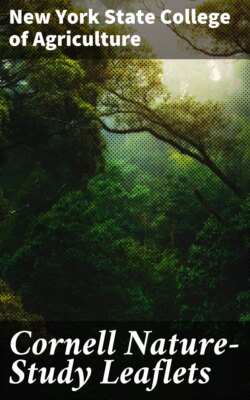Читать книгу Cornell Nature-Study Leaflets - New York State College of Agriculture - Страница 26
OTHER ANIMALS ADAPTED FOR NATURE-STUDY.
ОглавлениеThe Toad and Frog. The study of either of these two species is delightful spring work for any grade. Cornell Teachers' Leaflet, No. 9 (No. XVI, this volume); Wilderness Ways, p. 25.
Salamanders or Efts. Familiar Life of the Roadside.
Fishes. Observations upon goldfish or minnows kept in an aquarium should be made the basis of lessons upon the life of fishes. Study: (1) The shape of the body; see how it is especially adapted to rapid movement through the water. (2) The shape and arrangement of the fins, and their uses. (3) How the fish propels itself through the water. (4) How the fish breathes. (5) The shape of the fish's mouth, and how and what it eats. (6) Experiment to ascertain the ability of the fish to see and hear. Cornell Teachers' Leaflet, No. 21 (Nos. XIII and XXXVI, this volume).
Encourage observations of habits of different species of fish common in our ponds and streams. Study their eggs and the places where they are found. Teach the children the reason for the game laws, and impress upon them a true respect for those laws. Food and Game Fishes.
Mice. Some house mice in an improvised cage may be placed in the schoolroom, and the habits of the little creatures observed. Give them paper to see how they make their nests. Note how and what they eat, and how they clean themselves. Note shape of teeth and their use. If possible, study the wild mice. Squirrels and Other Fur Bearers, p. 111; Wild Life, p. 171.
Squirrels and Chipmunks. The work on these animals must be based on out-of-door observations. Try to get the pupils to discover for themselves answers to the following questions: How and where do they travel? What do they eat? Where and how do they carry their food? Do they store it for winter? If so, where? What do they do in winter? Squirrels and Other Fur Bearers, p. 15, p. 134; Wild Neighbors, p. 1.
Rabbits.—A domesticated rabbit should, if possible, be kept in the schoolyard so that the pupils may make their own observations upon its habits. Let them study: How and what it eats. The shape of its teeth. The form and use of the ears. How does it travel? What sort of tracks does it make, and why? From these observations lead the pupils to think of the life of the wild rabbit, how it is adapted to escape from its enemies and to get its food. Ways of Wood Folk, p. 41; Story of Raggylug.
Guinea pigs.—These little animals are easily kept in the schoolroom, and, though not particularly interesting in their habits, they prove attractive to the smaller children and may be studied in the same way as the other animals.
Domestic animals.—These need not be studied in the schoolroom, as the pupils, if they have opportunity, can make the observations at home. Studies of the horse, cow, pig, sheep, and goat, and also the cat and dog may be made most interesting. Such questions as these may be asked concerning each: What is the characteristic form of the animal? What is its clothing? What does it eat? How are its teeth adapted to its food? What is its chief use to man? How does it travel, slow or fast? How are its feet adapted to its way of running or walking? Has it a language? How many emotions can it express by sound? How many can it express by action? How does it fight, and what are its weapons? What sort of life did its wild ancestors live? How did they get their food, and how did they escape from their enemies?
Summary of methods of nature-study of animals.—Study only so much anatomy as is clearly adapted to the animal's ways of living. Observations made by the pupils should be arranged into lessons by either pupil or teacher. Such lessons make excellent English themes, and they may be adapted to any grade.
